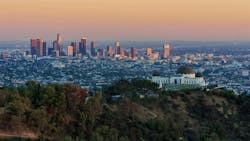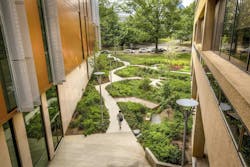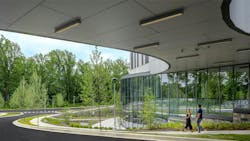4 ways designers can help chief heat officers reduce climate change risks
As our world becomes unpredictably hotter due to climate change caused by carbon emissions, governments and organizations are taking increasingly bolder actions to curb and mitigate associated risks. One fascinating emergence from this past summer has been the emergence of Chief Heat Officers (CHO).
Among other cities, we’ve seen Miami, Phoenix, and Los Angeles all create this new role—and its emergence couldn't be more timely. Climate change has made extreme heat more common and it's having tragic impacts. Data indicates extreme heat is killing more than five million people a year and deaths from severe heat strokes and related complications increased by 56% in the U.S. between 2018 and 2021.
Helping mitigate heat-related deaths and tragic health outcomes is a key focus of CHOs. The design community should absolutely offer a helping hand as there’s much we can do to support their missions. Here are a few ways the design community can be a valuable resource to CHOs to alleviate current risks and reduce future warming.
1. Create a strategy for shade
In a warmer world, shade is essentially invaluable. During extreme heat, those who can find shade are able to protect themselves and cool down. But, shade is also something far too many of us take for granted. In fact, there’s clear evidence that communities of color have 33% less tree canopy on average than majority white neighborhoods. And, residents living in poverty have 41% less tree canopy than communities with only 10% or less of the population in poverty.
As we think about major American cities like Los Angeles, Phoenix, Miami, etc. these are incredibly diverse cities with communities from all different socioeconomic backgrounds. There is no doubt that shade is inequitably shared across them. As CHOs work to solve this, they need a shade strategy that span both new trees but also buildings, built canopies and new infrastructure that can all provide life-saving cover during extreme heat. In addition, minimizing impervious hot surfaces like asphalt also helps reduce the “heat island” effect where heat is absorbed by parking lots and dark roofs and increases the ambient temperature of our cities.
CHOs should seek city-wide shade plans that encompass urban planning, landscape design, buildings, public infrastructure investments and more. Designers should absolutely be at the table as CHOs build these plans to help maximize efficiencies. And, these plans should be focused on fixing current inequities and preventing future disparities.
2. Rewild our cities and buildings
One of the most exciting movements in response to climate change has been a deeper focus on rewilding our urban and built environments. Rewilding translates to restoring areas of land more closely to their natural uncultivated state where natural plants and animals can once again thrive. The Global Rewilding Alliance is one example of a network of groups working to rewild the planet.
CHOs should embrace the idea of rewilding their cities and turn to designers to help implement responses. Effectively bringing more plants and greenery into our cities can help us better capture carbon and help restore biodiversity. Rewilding approaches demand rigor, though, as it’s not just about planting a bunch of trees. It's about creating a systematic and equitable plan to increase plant life across a city to maximize positive outcomes.
And at the same time, designers can help CHOs think about rewilding our built environment. We’ve been advocating for new ideas around how to rewild a hospital, a college campus, schools, museums and civic infrastructure. There’s no reason we can’t amplify nature in each of these spaces. Truly, every building has untapped potential when it comes to being part of the rewilding revolution, and designers can help CHOs unlock it.
3. Building electrification
The reliance buildings have on fossil fuels needs to end as we know the burning of these fuels is the leading agent of carbon emissions. Already, we’re seeing governments push cities in this direction with legislation like New York City’s new move to phase out the combustion of fossil fuels in new buildings and accelerate the construction of all-electric buildings.
There is great momentum in this area and here too designers can help CHOs amplify and accelerate their efforts around building electrification. Electrification is a key pillar of any building decarbonization roadmap and it breaks action steps down into three categories:
- Optimizing a building’s passive energy systems
- Selecting the best active energy systems
- Providing renewables
Following these steps with precision and establishing clear performance guidelines and acceptance criteria can ensure the best outcomes of measurable building decarbonization and electrification.
It’s not at all crazy for CHOs to look at their city’s building stock and want to reduce its reliance on fossil fuels by 50% in fast order. Working with the designers creating and renovating these buildings and the engineers they partner with will only streamline and accelerate goals.
4. Set new precedents
The CHOs’ toolkit to help our cities deal with extreme heat is ever-growing. Buildings are now exploring innovations such as algae-infused facades that help them sequester carbon. Elsewhere, new research is being advanced about eco-friendly insulation materials. Our team has also been advocating for organizations and cities to embrace the possibility of “growing” our buildings and materials using advanced techniques in Synthetic Biology.
The best time for bold climate action was thirty years ago; the second best time for old climate action is today. Given this, CHOs are entering their new roles already behind schedule. Partnering with design leaders exploring these cutting-edge ideas around building sustainability will only help them achieve better outcomes more rapidly. CHOs could be the loudest advocates for transforming our built environment from a hindrance to the planet to an incredible asset. It’s all possible and designers can help CHOs make it happen together.
By no means is the design community all CHOs need to excel in their newly established roles. The challenges they face are immense and it’s exciting to hear they recently convened to share best practices and grow as a community. However, as I’ve followed the news of more and more cities turning to CHOs, I’ve been fascinated. Our cities are filled with buildings and spaces that aren’t currently helping curb global warming—and we’d love to start conversions with each and every CHO about how we help them change that reality for the better of the planet.
About the author: Eric Corey Freed is CannonDesign's director of sustainability.




